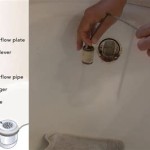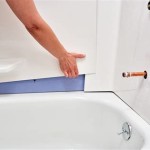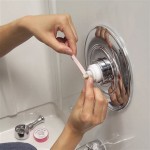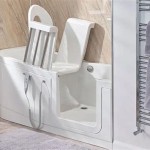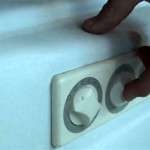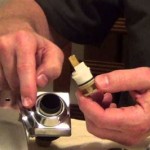How to Clean the Bathtub: A Comprehensive Guide
Maintaining a clean bathtub is essential for hygiene and preventing the accumulation of soap scum, mildew, and hard water stains. Regular cleaning not only prolongs the life of the bathtub but also creates a more pleasant and sanitary bathing environment. This article provides a comprehensive guide to cleaning the bathtub effectively, covering various methods and addressing specific cleaning challenges.
Selecting the Right Cleaning Supplies
The selection of appropriate cleaning supplies is the initial step in achieving a sparkling clean bathtub. Consider the type of material the bathtub is made of, as this will influence the choice of cleaning agents. Acrylic, fiberglass, porcelain, and cast iron bathtubs each require specific care. Abrasive cleaners, while effective at removing tough stains, can scratch and damage delicate surfaces like acrylic and fiberglass. For these materials, non-abrasive cleaners are recommended.
Commercially available bathtub cleaners are a convenient option. These cleaners are formulated to dissolve soap scum and kill mildew. Look for cleaners specifically designed for the type of bathtub material. Alternatively, homemade cleaning solutions can be effective and environmentally friendly. White vinegar, baking soda, and dish soap are common household ingredients that can be combined to create powerful cleaning agents.
In addition to cleaning solutions, appropriate cleaning tools are necessary. A non-abrasive sponge, microfiber cloth, or soft-bristled brush is ideal for scrubbing without damaging the bathtub surface. Stiff-bristled brushes can be used for grout and other hard-to-reach areas. A spray bottle is useful for distributing cleaning solutions evenly. Gloves should be worn to protect hands from harsh chemicals and potential irritants.
For specific cleaning challenges, specialized tools may be required. A pumice stone can be used carefully to remove stubborn stains from porcelain or cast iron bathtubs. A grout brush can effectively clean the grout lines between tiles. A squeegee can be used after each bath or shower to prevent water spots and mildew growth.
Step-by-Step Cleaning Process
The following step-by-step process outlines a general method for cleaning a bathtub, which can be adapted based on the chosen cleaning solution and the specific needs of the bathtub.
1.
Preparation:
Remove all items from the bathtub, including shampoo bottles, soap dishes, and bath toys. This allows for unobstructed access to all surfaces. Rinse the bathtub with warm water to loosen any surface dirt or debris.2.
Application of Cleaning Solution:
Apply the chosen cleaning solution generously to all surfaces of the bathtub, including the walls, faucets, and drain. If using a spray bottle, ensure even coverage. For stubborn stains or mildew, allow the cleaning solution to sit for several minutes to allow it to penetrate and dissolve the buildup. Follow the manufacturer's instructions for dwell time when using commercial cleaners.3.
Scrubbing:
Using a non-abrasive sponge, microfiber cloth, or soft-bristled brush, scrub all surfaces of the bathtub thoroughly. Pay particular attention to areas with visible soap scum, mildew, or stains. For grout lines, use a grout brush to scrub away any buildup. Apply moderate pressure while scrubbing, avoiding excessive force that could damage the bathtub surface.4.
Rinsing:
Once all surfaces have been scrubbed, rinse the bathtub thoroughly with warm water. Ensure that all traces of the cleaning solution are removed. Use a showerhead or a bucket of water to effectively rinse all areas of the bathtub. Pay attention to corners and crevices where cleaning solution may accumulate.5.
Drying:
After rinsing, dry the bathtub with a clean towel or microfiber cloth. This helps to prevent water spots and mildew growth. Pay particular attention to drying the faucets and other hardware. A squeegee can be used on the walls of the bathtub to remove excess water and prevent streaks.Addressing Specific Cleaning Challenges
Certain cleaning challenges require specific techniques and solutions. Soap scum, mildew, and hard water stains are common issues that can be addressed with targeted cleaning methods.
Soap Scum:
Soap scum is a residue formed from the combination of soap and hard water minerals. It appears as a white or gray film on the bathtub surface. To remove soap scum, a solution of equal parts white vinegar and water can be effective. Spray the solution onto the soap scum and allow it to sit for several minutes before scrubbing. For stubborn soap scum, a paste of baking soda and water can be applied and scrubbed with a non-abrasive sponge.Mildew:
Mildew is a type of fungus that thrives in damp environments. It appears as black or green spots on the bathtub surface and can emit a musty odor. To kill mildew, a solution of bleach and water can be used. Mix one part bleach with ten parts water and apply to the affected areas. Allow the solution to sit for several minutes before scrubbing and rinsing thoroughly. Ensure adequate ventilation when working with bleach. Alternatively, a commercially available mildew remover can be used following the manufacturer's instructions.Hard Water Stains:
Hard water stains are caused by mineral deposits in hard water. They appear as white or yellowish stains on the bathtub surface. To remove hard water stains, a solution of vinegar can be effective. Spray vinegar onto the affected areas and allow it to sit for several minutes before scrubbing and rinsing thoroughly. For particularly stubborn hard water stains, a paste of baking soda and vinegar can be applied and scrubbed with a non-abrasive sponge. A commercial hard water stain remover can also be used.Rust Stains:
Rust stains can occur around drains or from metal objects left in the bathtub. To remove rust stains, a commercial rust stain remover can be used. Follow the manufacturer's instructions carefully. Alternatively, a paste of lemon juice and salt can be applied to the rust stain and allowed to sit for several hours before scrubbing and rinsing. A pumice stone can also be used carefully to remove rust stains from porcelain or cast iron bathtubs.Grout Cleaning:
Grout lines between tiles are prone to dirt, mildew, and staining. To clean grout, a grout brush and a solution of bleach and water can be used. Scrub the grout lines thoroughly with the solution and rinse with water. For heavily stained grout, a commercial grout cleaner can be used. Ensure adequate ventilation when working with bleach. A baking soda and vinegar paste can also be used as a natural alternative.Preventative Measures for a Cleaner Bathtub
Preventative measures can significantly reduce the frequency and intensity of bathtub cleaning. Implementing the following practices can help maintain a cleaner bathtub and minimize the buildup of soap scum, mildew, and hard water stains.
1.
Rinse the Bathtub After Each Use:
After each bath or shower, rinse the bathtub with warm water to remove any soap residue or loose debris. This simple step can prevent the buildup of soap scum and make future cleaning easier.2.
Dry the Bathtub After Each Use:
After rinsing, dry the bathtub with a clean towel or squeegee. This helps to prevent water spots and mildew growth. Pay particular attention to drying the faucets and other hardware.3.
Ventilate the Bathroom:
Proper ventilation is crucial for preventing mildew growth. Ensure that the bathroom is well-ventilated by opening a window or running the exhaust fan during and after baths and showers. This helps to reduce humidity levels and inhibit mildew growth.4.
Use Liquid Soap Instead of Bar Soap:
Bar soap contains talc and other ingredients that contribute to soap scum buildup. Liquid soap is less likely to leave a residue and is therefore preferable for minimizing soap scum.5.
Regularly Clean the Showerhead:
The showerhead can harbor bacteria and mineral deposits. Regularly clean the showerhead by soaking it in a solution of vinegar and water. This helps to maintain a clean and sanitary bathing environment.6.
Consider a Water Softener:
If hard water is a persistent problem, consider installing a water softener. A water softener removes minerals from the water, reducing the formation of hard water stains in the bathtub and throughout the house.7.
Use a Bathtub Mat:
A bathtub mat can help to prevent slips and falls, but it can also trap water and create a breeding ground for mildew. Regularly clean the bathtub mat with soap and water or a mildew-killing solution. Consider using a mat that is designed to allow water to drain freely.By implementing these preventative measures and following the cleaning procedures outlined in this guide, maintaining a clean and sanitary bathtub can be achieved with relative ease. Regular cleaning not only enhances the aesthetic appeal of the bathroom but also promotes a healthier bathing environment.

How To Clean A Bathtub The Right Way In 9 Easy Steps
How To Clean A Bathtub Porcelain Acrylic Or Fiberglass

The Right Way To Clean And Scrub Your Bathtub Denver House Cleaning Services Cleaners Dashing Maids

How To Clean A Jetted Bathtub Bond Cleaning In Brisbane

How To Clean A Bathtub Maids By Trade

8 Easiest Ways To Clean Your Bathtub

How To Clean A Bathtub Homeadvisor

This Tip Takes The Pain Out Of Cleaning Your Bathtub

How To Clean A Bathtub Without Hurting Your Back Sparkle And Shine
/how-to-clean-bathtub-1900292-04-d36adf30dce848f0887a1f08ddc81d58.jpg?strip=all)
How To Clean A Bathtub The Right Way

